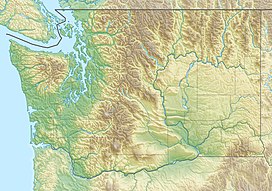Glacier Peak
| Glacier Peak | |
|---|---|
| Dakobed Takobia |
|

East slope of Glacier Peak with Cool (left), Chocolate (descending from summit), North Guardian and Dusty Glaciers (right)
|
|
| Highest point | |
| Elevation | 10,525+ ft (3,207+ m) NAVD 88 |
| Prominence | 7,498 ft (2,285 m) |
| Listing | |
| Coordinates | 48°06′45″N 121°06′50″W / 48.11251395°N 121.113804642°WCoordinates: 48°06′45″N 121°06′50″W / 48.11251395°N 121.113804642°W |
| Geography | |
| Location | Snohomish County, Washington, U.S. |
| Parent range | Cascade Range |
| Topo map | USGS Glacier Peak East |
| Geology | |
| Age of rock | |
| Mountain type | Stratovolcano |
| Volcanic arc | Cascade Volcanic Arc |
| Last eruption | 1700 ± 100 years |
| Climbing | |
| First ascent | 1898 by Thomas Gerdine |
| Easiest route | Rock/ice climb on Sitkum Glacier |
Glacier Peak or Dakobed (known in the Sauk Indian dialect of Lushootseed as "Tda-ko-buh-ba" or "Takobia") is the most isolated of the five major stratovolcanoes (composite volcanoes) of the Cascade Volcanic Arc in the U.S state of Washington. Located in the Glacier Peak Wilderness, the volcano is visible from the west in Seattle, and from the north in the higher areas of eastern suburbs of Vancouver such as Coquitlam and Port Coquitlam. The volcano is the fourth tallest peak in Washington state, and not as much is known about it compared to other volcanoes in the area. Local Native Americans have recognized Glacier Peak and other Washington volcanoes in their histories and stories. When foreign explorers reached the region, they learned basic information about surrounding landforms, but did not initially understand that Glacier Peak was a volcano. Positioned in Snohomish County, the volcano is only 70 miles (110 km) northeast of Seattle. The only volcano closer to Seattle is Mount Rainier, but as Glacier Peak is set farther into the Cascades and almost 4,000 feet (1,200 m) shorter, it is less noticeable than Mount Rainier.
Glacier Peak is one of the most active of Washington's volcanoes. The volcano formed during the epoch, about one million years ago, and since the most recent ice age, it has produced some of largest and most explosive eruptions in the state. When continental ice sheets retreated from the region, Glacier Peak began to erupt regularly, erupting explosively five times in the past 3,000 years. It has erupted repeatedly during at least six periods; two of these eruptions have been among the largest in Washington.
Remnants of past, prehistoric lava domes are main components of the summit of the volcano, in addition to its false summit, Disappointment Peak. Past pyroclastic flow deposits are easily visible in river valleys near the volcano, likely caused by lava dome collapse, along with ridges found east of the summit consisting of ash cloud remains. On its western flank, the volcano also has a lahar, or mudflow deposit, which runs for about 35 kilometres (22 mi) into the White Chuck River Valley around 14,000 years ago. Ten other pyroclastic flow deposits are visible, all identified as relatively 10,000 years old. There is also a considerably newer mudflow, about 5,500 years old, which covers an area of 15 kilometres (9.3 mi) between the same river valley, along with two small incidents both under 3,000 years old. Another lahar, of unidentified age, was rich in oxyhornblende dacite; and continued for 30 kilometres (19 mi) into the Sauk River.
...
Wikipedia

